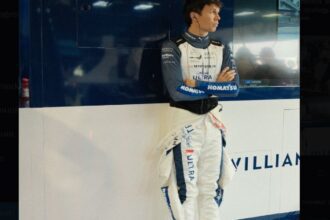Exclusive: Mercedes Stuns F1 with Game-Changing W15 Upgrades at Belgian GP –
Introduction to the Belgian Grand Prix Updates
The Formula 1 Belgian Grand Prix at Spa-Francorchamps is a highlight of the season, known for its high-speed straights and challenging corners. Teams bring specific updates to optimize performance for this unique track. This year, Mercedes has introduced five significant updates to the W15, aimed at enhancing performance and maintaining competitiveness.
Mercedes’ W15 Updates
Diffuser – Enhanced Local Load
Mercedes has made subtle changes to the diffuser roof profile of the W15. These modifications increase rear camber in the diffuser roof region, resulting in enhanced local flow acceleration. This increase in local downforce and drag aims to improve overall car performance. This update is particularly crucial for Spa, where balancing downforce and drag can significantly impact lap times.
Floor Edge – Forward Floor Load Improvement
1988 Belgian Grand Prix
Those were the days
No DRS, traction control, power steering….
Just the driver, the car and the talent #F1 pic.twitter.com/ztqpUwbxMt
— Senna (@sennatheking) June 28, 2024
The floor edge wing has been revised, featuring an additional flap element added over the forward section. This new element drops the local pressure behind the fence systems, thereby increasing forward floor load. The enhanced floor edge design is expected to provide better stability and control, essential for the high-speed sections of the Spa circuit.
Beam Wing – Drag Reduction Focus
A single element beam wing has been introduced to the W15. This low camber beam wing is designed to reduce local downforce and drag, making it suitable for high lift-to-drag (L/D) tracks like Spa. By optimizing the beam wing for drag reduction, Mercedes aims to improve straight-line speed, a critical factor on the long straights of the Belgian GP.
Front Wing – Circuit Specific Balance Range
The front wing has been updated with a low camber, small chord front wing flap. This reduced chord and camber element decreases local front wing load, allowing for a more balanced car setup when running low downforce rear wings. This update is tailored to the demands of Spa, where achieving the right balance between front and rear downforce is key to competitive lap times.
Halo – Drag Reduction Technique
The flap element has been removed from the Halo fairing. This change reduces local downwash and drag by altering the onset flow to the rear of the car. By minimizing drag, Mercedes aims to enhance the car’s aerodynamic efficiency, crucial for the fast and flowing nature of the Spa circuit.
Other Teams’ Updates for the Belgian GP
Ferrari’s Focus on Balance and Drag Reduction
Ferrari has introduced updates to the front wing and rear wing of their car. The new front wing flap design and trims are circuit-specific, providing the required aero balance range for Spa. Additionally, lower downforce top and lower rear wing designs have been implemented to meet the efficiency requirements of the track. These updates aim to optimize the car’s aerodynamic profile, balancing downforce and drag effectively.
McLaren’s Drag Reduction Strategy
McLaren has brought a low downforce rear wing and offloaded beam wing to Spa. The rear wing is designed to reduce drag efficiently, while the offloaded beam wing aims to increase the operating range of the low downforce wing. Additionally, the rear brake duct furniture has been updated to adapt to the new aerodynamic configuration. These updates are targeted at maximizing straight-line speed and overall aerodynamic efficiency.
Alpine’s Comprehensive Aerodynamic Enhancements
Alpine has introduced several updates, including reprofiled front wing flap elements, a redesigned engine cover, new rear corner ducts, a single element rear beam wing, and a lower camber rear wing assembly. These changes are designed to improve cooling efficiency, drag reduction, and aerodynamic performance. Alpine has also reprofiled the mirror stays to achieve better flow control towards the rear of the car, enhancing overall aerodynamic quality.
Red Bull’s Low Downforce Configuration
Red Bull has modified winglet profiles on the rear corner, introduced a biplane configuration beam wing, and reduced camber and chord on the rear wing. These updates are aimed at reducing downforce and drag, making the car more efficient for low downforce circuits like Spa. The biplane configuration continues to provide low pressure for the diffuser while reducing load and drag.
Sauber’s Focus on Flow Control and Efficiency
Sauber has updated the mirror geometry, reworked floor fences, and redesigned the front and rear wings for low drag requirements. The new mirror stays provide better flow control, while the reworked floor fences deliver a local load step with good flow quality. The redesigned front wing flap and rear wing upper flap improve aerodynamic efficiency, essential for the high-speed sections of Spa.
Haas’ Low Drag Configuration
Haas has introduced less cambered rear wing profiles and lower beam profiles to reduce drag. These updates provide further tuning options for the car’s overall drag level, optimizing performance for low drag circuits like Spa. By reducing local load efficiently, Haas aims to enhance straight-line speed and aerodynamic performance.
Expert Commentary
“These updates reflect the teams’ continuous efforts to optimize performance for specific tracks. The Belgian Grand Prix at Spa-Francorchamps is a unique challenge with its combination of high-speed straights and technical corners. Each team’s updates are tailored to maximize aerodynamic efficiency and balance, crucial for a strong performance at Spa,” said an F1 expert.
Conclusion
The updates brought by Mercedes and other teams to the Belgian Grand Prix highlight the importance of track-specific modifications in Formula 1. By focusing on aerodynamic efficiency, drag reduction, and balance, teams aim to gain a competitive edge at Spa. These updates will be crucial in determining performance in the upcoming race, showcasing the intricate engineering and strategic planning that defines Formula 1 racing.









